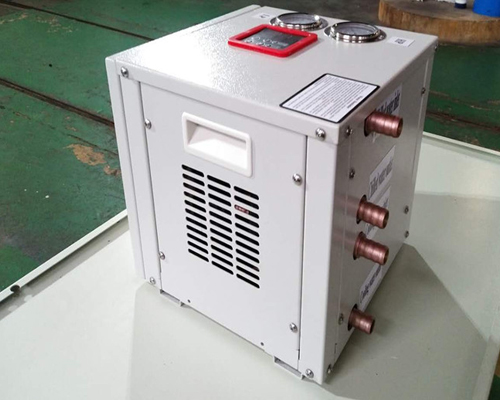Portable Chillers VS Central Chillers
There are two types of chillers: portable chillers and central chillers. Next, the chiller supplier will share with you.
Portable chillers
Portable chillers typically have smaller capacities (30-40 tons or less), simpler overall designs, and lower installation costs. Equipped with casters, they are easy to move, easy to connect (using flexible hoses) and easy to start.
Portable chillers are often optimized to provide a fixed amount of heat transfer capacity (in tons). They are ideal when a piece of process equipment requires a cooling stream at a significantly different temperature than the rest of the equipment.
Typically, portable refrigerators operate most efficiently when the cooling load is closely matched to the rated capacity of the refrigerator.

DC series small chillers use a DC power supply, using coolant as the heat transfer medium, transferring heat generated by other instruments or equipment that need to be cooled, and dissipating heat to the outside of the equipment through the refrigeration The cooling machine and the instrument and equipment rely on the pump pressure to form the normal temperature range. The cooling machine and the instrument and equipment rely on the pump pressure to form a closed medium circulation, and the temperature sensor detects the medium temperature to implement the control of the refrigerator. If you want to get more information about portable chillers for sale, please contact us.
Central chillers
Central chillers are typically larger in capacity, more complex in design, more energy-efficient as well as more costly to install.
The main advantage of a central chiller system is that it can handle multiple, larger and variable process loads that require cooling water at approximately the same temperature.
Central chillers have a number of features so they can be adjusted incapacity to meet changing production cooling needs.
-Independent process pumps and circulation pumps
-Large cooling water tanks
-Multiple (or variable speed) compressors
-More sophisticated control
A single central chiller can often provide better overall efficiency than multiple portable chillers with the same total capacity.
In order to choose between one central chiller or multiple portable chillers, the most important thing to know is the overall processing mix of the plant: typically, if 80% or more of the plant's material is processed at ±5°F temperature versus numerous portable units, the central cooling system will meet the demand with less operating tonnage, footprint and less routine maintenance.
On the other hand, if the temperature requirements of the material being processed vary greatly, then a properly sized portable cooler may be more effective. In some cases, the best solution is a hybrid cooler (a central system designed to handle all but the lowest or highest temperatures), coupled with a portable cooler for special or more extreme cooling needs.
However, obtaining significant long-term savings by using a central cooler system requires a significant upfront investment. Not only do central coolers require more sophisticated controls, automation and instrumentation to operate, but they also require extensive dedicated piping to circulate the coolant throughout the plant. However, both types require maintenance to keep the equipment healthy.
Clearly, there are many issues and factors to understand and consider before deciding on a heat transfer solution for a plastics processing plant. A competent, trusted member of the plant team can help clarify and quantify plant requirements and pick out the subjective factors and intangibles that will drive the final decision.
Key Considerations for Choosing Between Portable and Central Chillers
When evaluating the choice between portable chillers and central chillers, there are several key considerations that can influence your decision:
1. Space Availability
Portable chillers require less space and are ideal for facilities that have limited room for large equipment. In contrast, central chillers demand more space for installation due to their larger size and additional components.
2. Cooling Requirements
If your facility has varying temperature requirements across different processes, portable chillers may be more suitable as they can be easily relocated and adjusted to meet specific needs. Central chillers perform best when cooling load requirements are consistent.
3. Maintenance and Operation Costs
Consider the ongoing maintenance costs. Central chillers may have higher upfront costs but can lead to savings over time if your plant requires extensive cooling. Conversely, please contact us if you are looking for a cost-effective solution that requires minimal maintenance for less demanding cooling needs.
4. Energy Efficiency
It's essential to assess the energy efficiency of both systems. Central chillers often provide better energy efficiency for larger operations, while portable alternatives might conserve energy better for smaller, temporary setups.
Overall, evaluating your facility's specific cooling needs, energy consumption patterns, and available space will help you determine whether portable or central chillers are the right choice for your organization.

Comments